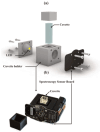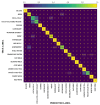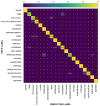Toward a User-Accessible Spectroscopic Sensing Platform for Beverage Recognition Through K-Nearest Neighbors Algorithm
- PMID: 40732392
- PMCID: PMC12299580
- DOI: 10.3390/s25144264
Toward a User-Accessible Spectroscopic Sensing Platform for Beverage Recognition Through K-Nearest Neighbors Algorithm
Abstract
Proper nutrition is a fundamental aspect to maintaining overall health and well-being, influencing both physical and social aspects of human life; an unbalanced or inadequate diet can lead to various nutritional deficiencies and chronic health conditions. In today's fast-paced world, monitoring nutritional intake has become increasingly important, particularly for those with specific dietary needs. While smartphone-based applications using image recognition have simplified food tracking, they still rely heavily on user interaction and raise concerns about practicality and privacy. To address these limitations, this paper proposes a novel, compact spectroscopic sensing platform for automatic beverage recognition. The system utilizes the AS7265x commercial sensor to capture the spectral signature of beverages, combined with a K-Nearest Neighbors (KNN) machine learning algorithm for classification. The approach is designed for integration into everyday objects, such as smart glasses or cups, offering a noninvasive and user-friendly alternative to manual tracking. Through optimization of both the sensor configuration and KNN parameters, we identified a reduced set of four wavelengths that achieves over 96% classification accuracy across a diverse range of common beverages. This demonstrates the potential for embedding accurate, low-power, and cost-efficient sensors into Internet of Things (IoT) devices for real-time nutritional monitoring, reducing the need for user input while enhancing accessibility and usability.
Keywords: IoT devices; KNN; beverage recognition; diet monitoring; machine learning; public health; sensing platform; smart cutlery.
Conflict of interest statement
The authors declare no conflicts of interest.
Figures








Similar articles
-
Short-Term Memory Impairment.2024 Jun 8. In: StatPearls [Internet]. Treasure Island (FL): StatPearls Publishing; 2025 Jan–. 2024 Jun 8. In: StatPearls [Internet]. Treasure Island (FL): StatPearls Publishing; 2025 Jan–. PMID: 31424720 Free Books & Documents.
-
Comparison of self-administered survey questionnaire responses collected using mobile apps versus other methods.Cochrane Database Syst Rev. 2015 Jul 27;2015(7):MR000042. doi: 10.1002/14651858.MR000042.pub2. Cochrane Database Syst Rev. 2015. PMID: 26212714 Free PMC article.
-
The Lived Experience of Autistic Adults in Employment: A Systematic Search and Synthesis.Autism Adulthood. 2024 Dec 2;6(4):495-509. doi: 10.1089/aut.2022.0114. eCollection 2024 Dec. Autism Adulthood. 2024. PMID: 40018061 Review.
-
Leveraging a foundation model zoo for cell similarity search in oncological microscopy across devices.Front Oncol. 2025 Jun 18;15:1480384. doi: 10.3389/fonc.2025.1480384. eCollection 2025. Front Oncol. 2025. PMID: 40606969 Free PMC article.
-
Sexual Harassment and Prevention Training.2024 Mar 29. In: StatPearls [Internet]. Treasure Island (FL): StatPearls Publishing; 2025 Jan–. 2024 Mar 29. In: StatPearls [Internet]. Treasure Island (FL): StatPearls Publishing; 2025 Jan–. PMID: 36508513 Free Books & Documents.
References
-
- Khot R.A., Mueller F. Human-Food Interaction. Found. Trends® Hum.–Comput. Interact. 2019;12:238–415. doi: 10.1561/1100000074. - DOI
MeSH terms
Grants and funding
LinkOut - more resources
Full Text Sources

